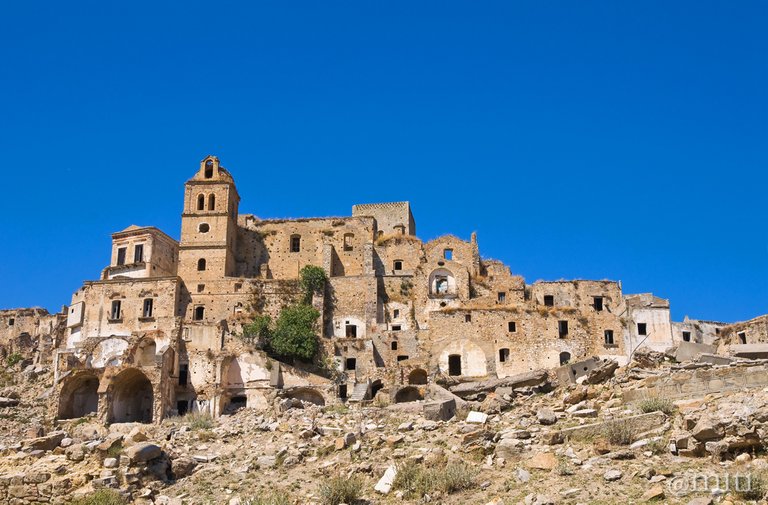
A panoramic view of Craco (Author's photo - All rights reserved)
Vista panoramica di Craco (Immagine dell'autore - tutti i diritti sono riservati)



Ciao a tutti,
questo è un viaggio attraverso l'Italia. Posterò una foto al giorno con una brevissima descrizione. Spero vi piaccia!

Craco è una città fantasma in provincia di Matera, nella regione meridionale italiana della Basilicata. Circondato dai Calanchi Lucani, Craco è una delle città italiane abbandonate che offre la rara vista di una vera città fantasma.
La città è stata costruita su una collina, composta da terreni ricchi di vari tipi di argilla: rossa, verde e grigio scuro, con diversi livelli di drenaggio che rendono il terreno altamente instabile. A causa della natura del terreno, Craco fu colpita da numerose frane di origine naturale, nel 1600, nel 1805, nel 1857 e nel 1933. Nonostante le precarie condizioni di vita, i Crachesi (abitanti di Craco) erano molto legati alla loro bellissima città medievale.
La storia di Craco inizia intorno al 540 aC, l'area era chiamata Montedoro e abitata da greci che si trasferirono nell'entroterra dalla città costiera di Metaponto. Le tombe che sono state trovate risalgono all'VIII secolo aC, il che suggerisce che l'insediamento originario risalga a quel tempo.
Il nome della città può essere datato al 1060 d.C., quando la terra era posseduta da Arnaldo, arcivescovo di Tricarico, che chiamò l'area Graculum, che significa in latino "campo arato".
Questa lunga associazione della Chiesa con la città ha avuto una grande influenza sugli abitanti.
Dal 1154 al 1168, il controllo del paese passò al nobile Eberto, probabilmente di origine normanna, che stabilì il primo controllo feudale sulla città. Poi, nel 1179, Roberto di Pietrapertosa divenne il Signore di Craco.
Sotto Federico II, Craco era un importante centro militare e la Torre del Castello divenne una prigione.
Nel 1276 fu istituita un'università in città. Durante il 13 ° secolo, Craco divenne feudo di Muzio Sforza. Durante il 1656, un epidemia di peste colpì Craco, con centinaia di persone che morivano e riducendo il numero di famiglie nella città.
Nel 1815, la città era abbastanza grande da dividerla in due quartieri: Torrevecchia, la zona più alta adiacente al castello e alla torre e il quartiere Della Chiesa Madre, l'area adiacente alla chiesa di San Nicola.
Alla fine del XIX secolo Craco contava diversi magnifici palazzi nobiliari, tra cui il Palazzo Rigirone, Palazzo Cammarota, Palazzo Miadonna e Palazzo Carbone, adornati con splendidi marmi e boiserie, affreschi colorati e imponenti lampadari, tutti rubati nel tempo , lasciando solo la pietra nuda.
La chiesa principale di Craco, la Chiesa Madre San Nicola, costruita nel XIV secolo, fu dedicata a San Nicola di Bari, vescovo di Myra, anche santo patrono della città di Craco. I Crachesi celebrano anche la Madonna della Stella, nella prima domenica di maggio.
Nel 1963, Craco cominciò ad essere evacuato a causa di una frana e gli abitanti si trasferirono nella valle di Craco Peschiera.
La frana sembra essere stata provocata da opere di infrastrutture, fognature e sistemi idrici. Nel 1972 un'alluvione peggiorò ulteriormente la situazione, impedendo un possibile ripopolamento del centro storico.
Dopo il terremoto del 1980, l'antico sito di Craco fu completamente abbandonato.
L'atmosfera nelle strade strette è inquietante, e inoltre c'è un avvertimento per i detriti che cadono, tuttavia, intorno alla città si possono ammirare imponenti gole. La vista della città in avvicinamento è piuttosto spettacolare ed è possibile salire sulla torre del castello in vetta per ammirare un panorama incredibile, ma ai turisti non è permesso di attraversare le rovine senza essere accompagnati.
Per il suo paesaggio drammatico e l'atmosfera unica, Craco è stato utilizzato come sfondo per molti film, tra cui The Passion di Mel Gibson (in particolare, l'impiccagione di Giuda), il film di James Bond Quantum of Solace e King David di Bruce Beresford.

Hello everyone,
I began a Photo Journey through Italy. I will post one photo every day with a little note of explanation. I hope you like it!

Craco is a ghost town in the province of Matera, in the southern Italian region of Basilicata. Surrounded by the Calanchi Lucani (Lucanian badlands), Craco is one of the abandoned Italian towns offering the rare sight of a true ghost town.
The town was built on a hill, composed of clay-rich soil of various types of red, green and dark grey clay, with different levels of drainage rendering the terrain highly unstable. Due to the nature of the terrain, Craco was affected by many landslides of natural origin, in 1600, 1805, 1857, and 1933. Despite the precarious living conditions, the Crachesi (inhabitants of Craco) were very attached to their beautiful medieval town.
The history of Craco start around 540 BC, the area was called Montedoro and inhabited by Greeks who moved inland from the coastal town of Metaponto. Tombs have been found dating from the 8th century BC, suggesting the original settlement dates back to then.
The town’s name can be dated to 1060 AD, when the land was the possession of Arnaldo, Archbishop of Tricarico, who called the area Graculum, which means in Latin “little-plowed field”.
This long association of the Church with the town had a great influence on the inhabitants.
From 1154 to 1168, the control of the village passed to the nobleman Eberto, probably of Norman origin, who established the first feudal control over the town. Then in 1179, Roberto of Pietrapertosa became the landlord of Craco.
Under Frederick II, Craco was an important military center and the Castle Tower became a prison.
In 1276, a university was established in town. During the 13th century, Craco became feudal tenure of Muzio Sforza. During 1656, a plague struck, with hundreds dying and reducing the number of families in the town.
By 1815, the town was large enough to divide it into two districts: Torrevecchia, the highest area adjacent to the castle and tower; and Quarter Della Chiesa Madre, the area adjacent to San Nicola’s Church.
By the end of the 19th century Craco counted several magnificent noble palaces, among which the Palazzo Rigirone, Palazzo Cammarota, Palazzo Miadonna and Palazzo Carbone, adorned with beautiful marbles and woodwork, colorful frescoes and impressive chandeliers, all of which have been robbed over time, leaving only the bare stone.
The main church of Craco, the Chiesa Madre San Nicola, built in the 14th century, was dedicated to San Nicola of Bari, bishop of Myra, also patron saint of the city of Craco. The Crachesi also celebrate the Madonna della Stella, on the frist Sunday of May.
In 1963, Craco began to be evacuated due to a landslide and the inhabitants moved to the valley of Craco Peschiera.
The landslide seems to have been provoked by works of infrastructure, sewer and water systems. In 1972 a flood worsened the situation further, preventing a possible repopulation of the historic center.
After the earthquake in 1980, the ancient site of Craco was completely abandoned.
The atmosphere in the narrow streets is eerie, and in addition there is a warning for falling debris, however, around the town impressive ravines can be admired. The view of the town on approach is quite spectacular and it is possible to walk up to the castle’s tower at the summit to admire an amazing panorama but tourists are not permitted to walk through the ruins unaccompanied.
Because of its dramatic landscape and unique atmosphere Craco has been used as a backdrop for many movies, among which Mel Gibson’s The Passion (more specifically, the hanging of Judas), the James Bond movie Quantum of Solace and Bruce Beresford’s King David.

| Tipo di foto / Category | Paesaggio / Landscape view |
| Esposizione / Settings | 1/200 sec, ISO 200, f/10 |
| Camera | Nikon D5000 |
| Lente / Lens | Tamron SP 17-50mm f/2.8 XR Di II LD |
| Filtro / Filter | Polarizzatore Hoya / Hoya Polarizing filter |
| Cavalletto / Tripod | Manfrotto MKC3-P01 |
| Località / Location | Craco (Matera), Italia |
| Software | Photoshop |


A panoramic view of Craco (Author's photo - All rights reserved)
Vista panoramica di Craco (Immagine dell'autore - tutti i diritti sono riservati)
beautiful day
Undoubtedly a beautiful landscape, thank you for sharing this story with us!!!
Congratulations, Your Post Has Been Added To The Steemit Worldmap!
Author link: http://steemitworldmap.com?author=mitiPost link: http://steemitworldmap.com?post=a-journey-through-italy-one-photo-every-day-134-craco-eng-ita
Want to have your post on the map too?
Veramente interessante Craco, avevo visto proprio qualche mse fa una puntata di Ghost Town su Rai 5 dedicata a questo paese.
Si, io l'ho visitata quando si poteva andare liberamente ovunque.. adesso si fanno solo visite guidate con caschetto protettivo ed esperti che ti guidano.
Che posto spettacolare!!!
La prima foto di Crack sembra molto un paese del. Olografo che si affaccia sul Grand Canyon!
Credo che il correttore del cell abbia fatto scherzi.. :D
🙈
Replicò:
Che posto spettacolare!!!
La prima foto di Craco sembra molto un paese del Colorado che si affaccia sul Grand Canyon!
Posted using Partiko Android
Ahahah.. si è vero, hai ragione. Sono i famosi Calanchi.
Congratulations @miti! You have completed the following achievement on the Steem blockchain and have been rewarded with new badge(s) :
Click on the badge to view your Board of Honor.
If you no longer want to receive notifications, reply to this comment with the word
STOPDo not miss the last post from @steemitboard:
Super creative article keep it up @miti
Posted using Partiko Android
Thanks!
Superb Photo with nice Article...
Your comment is considered SPAM... Take a look in this guide:
https://steemit.com/steemit/@miti/a-complete-guide-for-newcomers-and-minnows-to-avoid-a-possible-spam-and-to-write-good-comments
It will help you.
nice photo capture i like it resteemed your post @insomniacsk
Nice click beautiful... awasome..
You got a 47.94% upvote from @ocdb courtesy of @miti!
Truly beautiful
Posted using Partiko Android
Congratulation miti for very nice picture